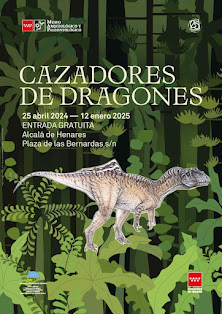Durante el desarrollo del XVI Annual Meeting de la EAVP, los dinosaurios terópodos tuvieron un pequeño hueco entre tanto Sauroposium y Crocoposium. Durante el último día del congreso, tuvo lugar la sección "Ornithoscelida", donde se comunicaron charlas y póster tanto de terópodos como de ornitisquios. En esta sesión, Elena Cuesta, miembro del GBE, participó con una charla sobre la osteología craneal de Pelecanimimus, mostrando además resultados del primer escáner en 3D que se realiza en este ejemplar. Aunque el trabajo es preliminar ya se muestran resultados interesantes como que Pelecanimimus tiene varias sinapomorfías de Ornithomimosauria y que muestra una serie de autapomorfías ligadas a su dentición, como una dentario sin desviación anteroventral o la presencia de numerosos dientes en ambas mandíbulas.
Este es uno de los primeros trabajos sobre este maravilloso ejemplar, que aún tiene mucho que mostrarnos. Para más información sobre esta ponencia, aquí os dejamos el resumen (en inglés):
-----Pelecanimimus polyodon was discovered in 1993 in the Spanish Barremian fossil site of Las Hoyas, being the first ornithomimosaurian described in Europe. So far, there is no detailed description of the holotype of Pelecanimimus that is composed by the anterior half of an articulated skeleton that preserves evidence of soft-tissues as a soft occipital crest and a gular structure.A detailed osteological description of the skull of Pelecanimimus has been carried out, and its features have been compared with those of other ornithomimosaurian. A CT scan and 3D reconstruction have allowed to decipher some features not previously available.Pelecanimimus shares with other ornithomimosaurs an enlogated premaxilla, a sharp posterior margin of the maxilla, a well-developed jugal ramus of palatal, a hypertrophied prefrontal, and a parasphenoid bulba. However, Pelecanimimus also have several primitive features such as a subnarial foramen, a premaxillary process not reaching the antorbital fossa and a pneumatic recess in the anterior ramus of jugal. Undoubtedly, the most striking feature of Pelecanimimus is the presence of approximately 200 premaxillary, maxillary and dentary teeth, present only also in Nqwebasaurus.Over the last 25 years, the known diversity of the ornithomimosaurs has increased throughout the world. The placement in context of Pelecanimimus features in current phylogenetic proposals is especially interesting to shed light on the feeding behaviour of Ornithomimosauria.
Más información:





























No hay comentarios:
Publicar un comentario